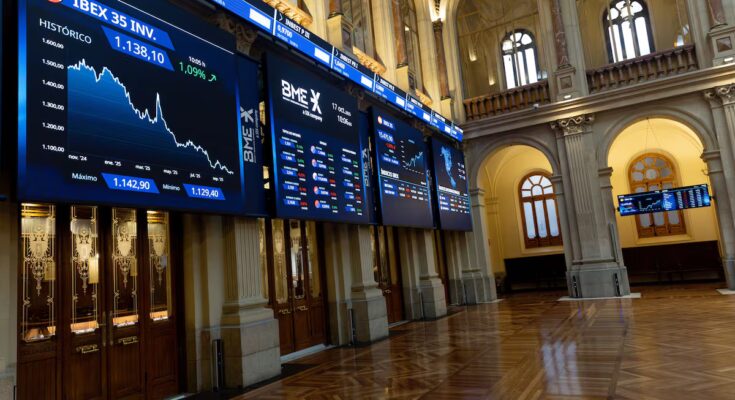In recent years, share buybacks have become one of the hallmarks of the Spanish banking sector. Since 2021, the six large listed banks (Santander, BBVA, CaixaBank, Sabadell, Bankinter and Unicaja) have shelled out almost 21,000 million euros to repurchase and redeem 5,000 million securities, equal to 12.1% of their total capital.
Santander leads the quantity of these operations. The entity paid almost 9.5 billion euros to buy back 14.1% of its shares over these five years. Santander’s shareholder remuneration policy is based on allocating half of its annual profits, split equally, between a cash dividend and share buybacks. BBVA follows, with an outlay of 6,400 million to acquire and volatilize 13.5% of the capital. The entity of Basque origin has carried out some of the most ambitious share buyback programs in the European banking sector and, once its takeover bid to acquire Sabadell fails, analysts expect a new mega buyback of shares between 3,000 and 6,000 million.
CaixaBank spent 3.8 billion to cut its capital by 12%. Sabadell adds 1,206 million euros of buybacks with which it acquired 10% of its capital. Unicaja reduced just 3%, with 100 million euros, while Bankinter is the only entity that has not carried out buybacks in this period. The bank maintains the policy of distributing 50% of the annual profit among shareholders through the payment of a dividend, always in cash.
Behind these operations there are two very different phases. The first began with the long period of zero and negative rates. Between 2016 and 2022, entities saw their margins shrink to record lows. Profitability has collapsed and with it stock market valuations. For years, Spanish banks have operated well below their book value. This means that the market valued their assets for less than their accounts reflected. In this context, the share buyback was a strategic decision.
Banks began to withdraw securities from the market at a price that did not reflect their true value, improving profitability for shareholders. Fewer shares outstanding means more earnings per share and more returns. But the scenario has completely changed. Rising rates from 2022 have led Spanish banks to make years of historic profits, with high margins and all entities are now trading above their book value. Does it make sense to continue buying back shares in this new cycle?
For RBC Capital Markets the answer is yes. “We believe that share buybacks are sustainable despite improving sector valuations. The fact that banks are trading above their book value does not imply that their effectiveness as a method of distributing excess capital has completely diminished,” explains Pablo de la Torre Cuevas, an analyst at the firm. “Many U.S. and Canadian banks are trading substantially at more than double their book value and are maintaining their repurchase programs,” he adds.
Miruna Chirea, Iberian banking analyst at Jefferies, agrees that buyback programs have not peaked. “We believe that in the coming years Spanish banks will continue to resort to buybacks, in addition to the dividend policy, to return excess capital. At current valuation levels, the return on investment, around 10%, is in line with the cost of capital.” But it introduces a nuance in that entities will now focus more on investing excess capital to increase business growth. “The growth environment in Spain today is very different from that of years ago: strong GDP growth and low private leverage. This should allow credit to grow more than in other large European economies. Banks will prioritize deploying capital towards profitable growth with double-digit returns before buying back shares,” he explains.
The ECB also analyzed the evolution and effects of share buybacks. In a recent blog post, the regulator acknowledged the role of buybacks in post-pandemic normalization, but warned that with record profits, “entities must carefully consider whether to preserve capital from possible future risks or allocate it to shareholder remuneration.”
At Morningstar the approach is different. “The bank’s management creates value by buying back shares when they are trading below their intrinsic value. If they are overvalued, the value is destroyed. Regardless of the book multiple, BBVA and Santander seem reasonably valued to us. This leaves us indifferent between buybacks or dividends,” explains the company’s analyst Johann Scholtz. But it also introduces a new factor: the current valuation reduces the cost of capital, which makes “acquisitions more attractive than buybacks or dividends,” he points out.
In any case, the changing cycle places banks in a more challenging equilibrium. For years the market has rewarded the withdrawal of undervalued stocks. But the current context requires us to demonstrate that every euro of retained capital is capable of generating more value than what is returned. And although in general the purchase of shares demonstrates managers’ confidence in the stock market listing, not the entire market shares this view. The former president of the National Securities Market Commission (CNMV) has already publicly expressed his rejection of buybacks because, in his opinion, they do not create value in a clear way and also do not benefit all investors equally, but only those who remain shareholders. It also asks that banks avoid presenting these operations as shareholder remuneration.



